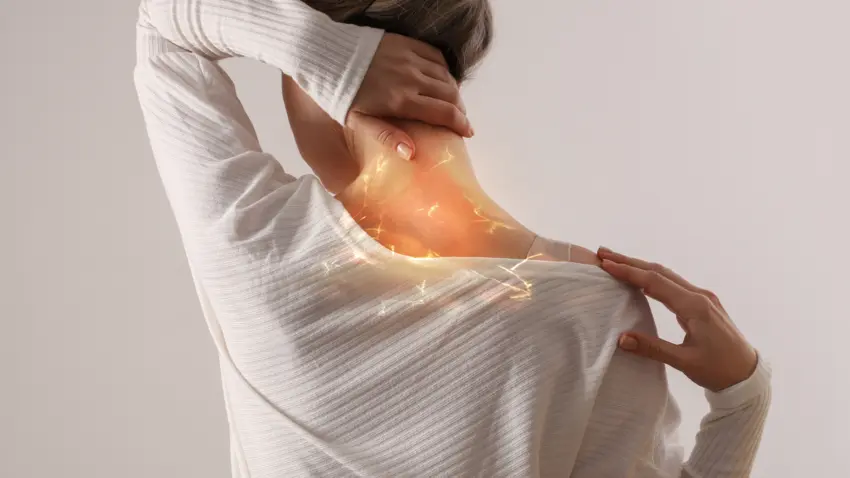What’s more painful than neck pain? Very common, it can appear when you wake up or after a long day of work… The good news in all this is that neck pain is nothing to worry about in most cases. You can often even relieve them yourself. And this, only in the space of a few days! However, some cases absolutely require seeing a doctor… What are the causes of neck pain? How to relieve them? When should you consult? We answer all your questions in our article!
What are the symptoms of neck pain?
Cervicalgia: a scholarly name which simply refers to pain located at the back of the neck. We also talk about cervical pain or neck pain! But whatever you call it, this pain is the main symptom present. Depending on the cause of neck pain, it can:
- Appear suddenly, during the day or upon waking;
- Or settle in gradually.
Most of the time, it disappears after a few days to a few weeks. But there are chronic forms, lasting more than 6 months! Also note that neck pain can be accompanied by other symptoms. The most common of them being:
- Pain in the trapezius (upper back muscle extending to the shoulder);
- Headaches;
- Neck stiffness and a head tilted to the side or forward, in case of stiff neck;
- More or less marked difficulty turning the head;
- And/or dizziness.
Neck sprain, stiff neck… What are the common causes of neck pain?
While there are many possible causes of neck pain, the most common are:
- Prolonged maintenance of a bad position… During your sleep for example! In fact, it is generally because we went to bed “badly” that we wake up with a sore neck. We then simply speak of postural neck pain. That being said, this type of pain can also appear if you are sitting incorrectly in front of your computer… Or if you hold your cell phone stuck between your ear and your shoulder for too long, for example;
- Contractures of the neck muscles. What we classically call a stiff neck! This can also be due to a bad position during your sleep. Or appear if you turn your head too suddenly;
- Trauma (e.g. Car accident, fall during a sporting activity). In the event of ligament damage, this leads to a cervical sprain such as “whiplash” for example;
- A “stuck” nerve, particularly due to a herniated disc. In this case, the pain can radiate into the arm. We then speak of cervicobrachial neuralgia.
- And cervical spondylosis in the elderly.
Other Less Common Causes of Neck Pain to Know About
More rarely, neck pain can also reveal a more or less serious illness. We then speak of “symptomatic neck pain”, because this pain is one of the symptoms of the disease in question. Among the different possible pathologies, let us cite above all:
- Various infectious and/or inflammatory diseases, directly affecting the neck. Like ankylosing spondylitis for example. This is a kind of chronic inflammation of the joints. While it can cause neck pain, it can also cause back pain. As well as various “stiffness” in the wrists, knees, etc. Also note that this disease manifests itself in outbreaks, interspersed with periods of calm. The sooner it is taken care of, the less likely you are to suffer from complications;
- Sometimes the presence of a tumor, in the context of neck cancer for example. But it’s really not very common!
How to relieve neck pain yourself?
Generally, you can easily relieve postural neck pain at home. Same fight for the “simplest” stiff necks! The right attitude:
- Take painkillers available without a prescription;
- Keep your neck warm (e.g.: scarf);
- Apply warm compresses to the sore area;
- Do “gentle” stretching and relaxation exercises. You can even try meditating because stress increases pain!
And to prevent another “crisis”? Above all, be sure to correct your posture. Even if it means investing in an ergonomic pillow for example, if you are a subscriber to neck pain when you wake up!
Neck pain: when to consult?
It is always recommended to consult a doctor if:
- Your neck pain persists or worsens despite 48 hours to 72 hours of “home care”. Even more so if they are accompanied by other symptoms such as headaches;
- The pain radiates to the arm;
- Your neck pain follows a shock or blow. Normally it is necessary to consult immediately as a precaution because this area is fragile. Is your injury a few days old? It’s not too late to see a doctor! In any case, do not ignore it if suspicious symptoms appear (e.g.: tinnitus, vision problems, memory loss);
- Your pain is accompanied by a high fever;
- You feel a suspicious mass in the neck area;
- You have already suffered from neck pain several times this year.
If in doubt, you can quickly consult a doctor by video to reassure yourself! You may need to have an X-ray and other tests to narrow down the diagnosis. As for treatment, it depends on the cause of your pain. However, be aware that it will be medicated in most cases. Indeed, operations are rare: they are only used in cases of absolute necessity!





